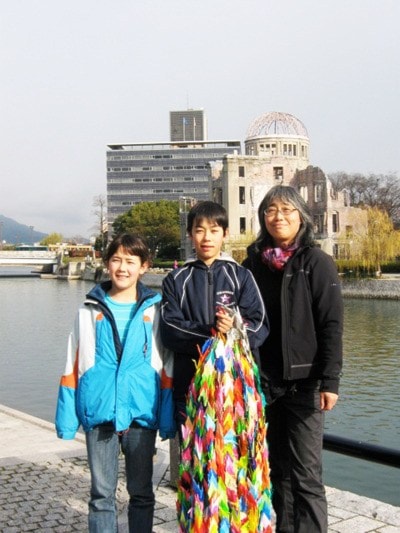Sunshine reflecting on flowing rivers, a lot of bridges, street cars and warm-hearted people. These words come up when I recall Hiroshima.
We arrived at Hiroshima station in the early afternoon on Dec. 25. After dropping our luggage off at our hotel, we hurried to Hiroshima Peace Memorial Museum where two volunteers welcomed us for a tour of the museum and peace park.
Inside the museum was comfortably dim, spacious and welcoming.
It was very difficult to imagine that the atom bomb was dropped and burnt everything there.
I was surprised and also glad to see so many people, young and old, Japanese and non-Japanese were there with a sort of respect and dignity.
What happened on August 6, 1945 in Hiroshima and how it had been planned were explained and displayed well. We could also get some information on Nagasaki.
Some copies of letters caught my eye - letters of protest against nuclear device tests. These started in 1946 and the mayor of Hiroshima City has been sending protesting letters to the countries every time a nuclear device is tested. The three latest ones were sent to Mr. Obama after the tests in the US last year.
There was a corner to introduce Sadako Sasaki whose story inspired us to fold 1000 paper cranes with a lot of help from our community. She was exposed to the atomic bomb when she was two and developed leukemia when she was 10.
She set a goal to fold 1000 cranes with the hope to be stronger by the time she got there. She died of cancer when she was 12, before she reached the goal. There was an exhibition of some small cranes Sadako folded.
After a tour of Peace Memorial Museum, we walked around Peace Park.
First we visited the tree which survived from the atomic bomb. This has been a symbol of life. After the bomb, it was said no living creature could live there for next 75 years, but to their surprise, this tree was not killed and a came to life within a year.
Next we visited Atomic Bomb Dome and Children’s Peace monument — a girl holding a big paper crane over her head — which was inspired by Sadako.
Since it was getting dark, we hurried to other important places to visit. There were many other monuments in the park for the people who had to die — not only Japanese but a lot of people from abroad.
We came to a big mound built where a temple used to be before the bomb explosion. The remains of 70,000 unidentified people were originally buried there.
When they identify people, their bones have been returned to the families and relatives they belonged to and even to this day, 66 years later, the identification work has continued. Our heart sank with deep sorrow and we could not stop praying for them when we saw this.
We headed to Children’s Peace Monument again to dedicate our cranes the next morning.
It was a beautiful day. A booth was set to hang cranes from all over the world.
We prayed for the children and people who could not fulfill their lives and hung the cranes there at the bottom of Children’s Peace Monument.
Our visit to Hiroshima was one of the most memorable trips of our lives.
We all felt the importance of peace — to be brave, not to fight, to be patient and to seek peaceful solutions whenever we face conflict. And these are our new year’s resolutions.
